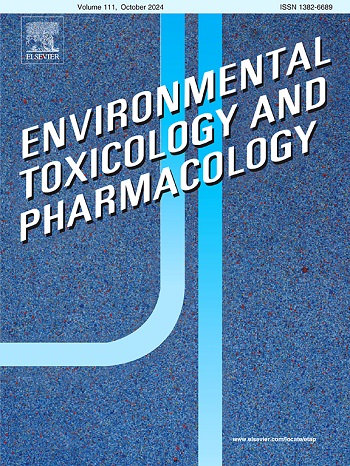空气中细颗粒物(PM2.5)有机提取物对神经元细胞的细胞毒性和代谢作用
IF 4.2
3区 环境科学与生态学
Q2 ENVIRONMENTAL SCIENCES
引用次数: 0
摘要
空气中的细颗粒物(PM2.5)与神经系统疾病有关,但其对细胞和代谢的影响仍不完全清楚。本研究评估了来自巴西圣保罗的PM2.5样本对SH-SY5Y神经母细胞瘤细胞的细胞毒性和代谢影响。即使在低毒性水平(IC10-IC30)下,PM2.5有机提取物也会诱导细胞凋亡,增加TNF-α分泌,并引发适度的氧化反应。代谢组学分析显示能量产生途径下调,包括糖酵解和TCA循环,以及ATP和磷酸肌酸水平降低。代偿性适应是明显的,如增加脯氨酸氧化,脂质积累和激活肌酸-磷酸肌酸系统。单碳代谢也受到影响,其变化表明叶酸和蛋氨酸循环受到抑制。谷胱甘肽水平升高表明抗氧化反应增强。这些发现强调了PM2.5如何破坏神经元能量稳态和氧化还原平衡,为空气污染相关神经毒性的细胞机制提供了新的见解。本文章由计算机程序翻译,如有差异,请以英文原文为准。
Cytotoxic and metabolic effects of organic extracts from airborne fine particulate matter (PM2.5) in neuronal cells
Airborne fine particulate matter (PM2.5) has been linked to neurological diseases, but its cellular and metabolic effects remain incompletely understood. This study assessed the cytotoxic and metabolic impact of PM2.5 samples from São Paulo, Brazil, on SH-SY5Y neuroblastoma cells. Even at low toxicity levels (IC10–IC30), PM2.5 organic extracts induced apoptosis, increased TNF-α secretion, and triggered moderate oxidative responses. Metabolomic analyses revealed a downregulation of energy-producing pathways, including glycolysis and the TCA cycle, along with decreased ATP and phosphocreatine levels. Compensatory adaptations were evident, such as increased proline oxidation, lipid accumulation, and activation of the creatine-phosphocreatine system. One-carbon metabolism was also affected, with changes suggesting suppression of the folate and methionine cycles. Elevated glutathione levels indicated an enhanced antioxidant response. These findings highlight how PM2.5 disrupts neuronal energy homeostasis and redox balance, offering new insights into the cellular mechanisms of air pollution-related neurotoxicity.
求助全文
通过发布文献求助,成功后即可免费获取论文全文。
去求助
来源期刊
CiteScore
7.00
自引率
4.70%
发文量
185
审稿时长
34 days
期刊介绍:
Environmental Toxicology and Pharmacology publishes the results of studies concerning toxic and pharmacological effects of (human and veterinary) drugs and of environmental contaminants in animals and man.
Areas of special interest are: molecular mechanisms of toxicity, biotransformation and toxicokinetics (including toxicokinetic modelling), molecular, biochemical and physiological mechanisms explaining differences in sensitivity between species and individuals, the characterisation of pathophysiological models and mechanisms involved in the development of effects and the identification of biological markers that can be used to study exposure and effects in man and animals.
In addition to full length papers, short communications, full-length reviews and mini-reviews, Environmental Toxicology and Pharmacology will publish in depth assessments of special problem areas. The latter publications may exceed the length of a full length paper three to fourfold. A basic requirement is that the assessments are made under the auspices of international groups of leading experts in the fields concerned. The information examined may either consist of data that were already published, or of new data that were obtained within the framework of collaborative research programmes. Provision is also made for the acceptance of minireviews on (classes of) compounds, toxicities or mechanisms, debating recent advances in rapidly developing fields that fall within the scope of the journal.

 求助内容:
求助内容: 应助结果提醒方式:
应助结果提醒方式:


